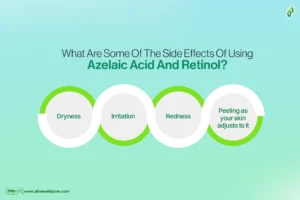
Last Updated on November 13, 2024 by Helena Akter
Among the most popular skincare components are azelaic acid and retinol. In fact, each possesses the potential for greatness as well as catastrophic consequences. But can you use azelaic acid with retinol?
Yes, you can do it. But if you apply them at the exact same time, you can experience skin irritation. That’s why, you alternate days or use one in the daytime and one at night. However, if you’re prone to sensitive skin, beware of over-exfoliating.
Whether you’re dealing with acne or hyperpigmentation, it’s easy to get caught up in the confusion. So, get ready for some clarity as we explore the world of these powerhouse ingredients and find out what they go together.
What Goes First Azelaic Acid Or Retinol?
Well, some skincare products already have this power combo for you! It’s the most convenient way. But if you prefer using them separately, you can find more detailed information on azelaic acid and retinol.

Now, when you’re just getting started, we suggest introducing these ingredients one by one. You can try retinol for a month before switching to azelaic acid or the other way around.
This way, if any issues pop up, you’ll know who the troublemaker is. Plus, your skin will have time to adjust.
And remember, if you feel overwhelmed using both at once, switch them at night. However, don’t apply retinol during dawn, as it makes your skin more sensitive!
Can You Use Azelaic Acid with Retinol Together?
Yes, using retinol and azelaic acid together is possible. As an effective treatment for hyperpigmentation, it is particularly beneficial for post-inflammatory hyperpigmentation, dark spots, and melasma.
If you have oily, blemish-prone skin, teaming up with azelaic acid and retinol can be a powerful duo to combat those concerns.
Here are some studies for your peace of mind —
- In studies, both substances were found to boost azelaic acid’s effectiveness in healing acne and acne-related scarring. And it also helps in reducing hyperpigmentation.
- People with all skin types will benefit from it, even those with darker skin!
- Azelaic acid has been shown to enhance retinol’s anti-acne properties. Thus, if you suffer from severe acne, combining these two will significantly speed up the healing process.

However, don’t forget to protect your skin against free radicals when using these ingredients. Whenever you’re out, wear an SPF of 30 or higher to protect your skin. You must protect your skin.
What Are Some Of The Side Effects Of Using Azelaic Acid And Retinol?

If you plan to use retinol and azelaic acid, you should be aware of potential side effects. Let’s break it down in a friendly way!
Retinol, being a powerful ingredient, can initially cause —
- Dryness
- Irritation
- Redness
- Peeling as your skin adjusts to it
On the other hand, azelaic acid is generally well-tolerated, even by sensitive skin, and rarely leads to severe side effects. However, since everyone’s skin is unique, results may vary.
In the case of severe acne and sensitive skin, retinol and azelaic acid can speed up the healing process. It might cause some irritation, but the benefits outweigh the temporary discomfort.
But if your acne isn’t as severe, resist the temptation to go overboard. Irritating your skin in hopes of faster results is not a wise move and will only set back your journey to recovery.
How to Use Azelaic Acid with Retinol?
When you apply azelaic acid and retinol in combination
- It doesn’t matter which order you apply them, so no need to stress!
- Start by applying them individually to identify any negative reactions and protect your skin barrier.
In the case of using azelaic acid, you can
- Apply it twice per day, although a single use is enough
- If using it a single time, use it first thing in the morning
- It’s a common recommendation from experts, making it easier to incorporate multiple active ingredients.
Plus, when it comes to retinol, you should
- Use it only one time
- It’s best to avoid sunlight as retinol degrades when exposed to it
- You can either apply sunscreen over retinol or use it exclusively at night.
- Apply it at night to align with your skin’s natural renewal process
Most importantly moisturize and protect
- After using retinol, add a moisturizer to tackle the dryness it could produce.
- Put on sunscreen as the last step of your beauty routine if you spend time outside.
Who Should Use Azelaic Acid?
Azelaic acid is perfect for those with acne or dark spots who are unable to tolerate retinol because of their sensitive skin. What makes azelaic acid even better is its gentle nature. Because of its greater molecular size, it ranks as one of the mildest dermatological acids available.
Plus, it doesn’t mess with your oil production, which means it can work wonders for people with excessive dryness. However, those with sensitive or allergic skin might feel azelaic acid somewhat irritating in rare situations.
But for the majority, it’s a fantastic option to address skin concerns with ease.
Who Should Use Retinol?
Almost any skin type can benefit from retinol. It’s the ultimate over-the-counter wrinkle fighter, tackling acne, wrinkles, and hyperpigmentation. You can however couple it up with a soothing and hydrating component for extra benefits based on your skin’s level of sensitivity.
How Often Can Azelaic Acid And Retinol Be Used Together?
You can apply azelaic acid two times a day at max, while retinol is best applied once daily. As both are active ingredients, you might prefer using azelaic acid during the daytime and retinol at night.
Keep in mind that the strengths of azelaic acid and retinol differ. You can get azelaic acid without a prescription in concentrations of 10% at max. When it comes to retinol, you won’t need a prescription for 1%.
No matter how you decide to include them in your daily skincare regimen, remember to shield your skin with reliable sunscreen.
On top of that, find your ideal schedule—whether you’re a morning azelaic acid person or a nighttime retinol lover. To further support your skincare journey, try your best to create healthy eating habits.
Wrapping Up
This brings us to the end of your burning question “Can you use azelaic acid with retinol?“. Now that we are equipped with profound knowledge, you can boldly navigate the path toward vibrant skin.
Remember, to introduce these ingredients individually to avoid potential reactions. You can incorporate azelaic acid into your routine twice daily, while retinol is ideally applied once, preferably in the evening.
Don’t overlook the importance of moisturizing and shielding your skin with sunscreen.







